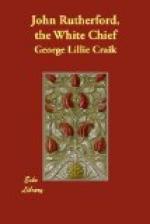[Footnote B: Transactions New Zealand Institute, volume xxiii., page 453.]
[Footnote C: “Journal of the Polynesian Society,” volume x., page 35.]
JOHN RUTHERFORD
The white chief.
CHAPTER I.
John Rutherford, according to his own account, was born at Manchester about the year 1796. He went to sea, he states, when he was hardly more than ten years of age, having up to that time been employed as a piecer in a cotton factory in his native town; and after that he appears to have been but little in England, or even on shore, for many years.
He served for a considerable time on board a man-of-war off the coast of Brazil; and was afterwards at the storming of San Sebastian, in August, 1813. On coming home from Spain, he entered himself on board another king’s ship, bound for Madras, in which he afterwards proceeded to China by the east passage, and lay for about a year at Macao.
In the course of this voyage his ship touched at several islands in the great Indian Archipelago, among others at the Bashee Islands,[D] which have been rarely visited. On his return from the east he embarked on board a convict vessel bound for New South Wales; and afterwards made two trading voyages among the islands of the South Sea.
It was in the course of the former of these that he first saw New Zealand, the vessel having touched at the Bay of Islands, on her way home to Port Jackson.
His second trading voyage in those seas was made in the “Magnet,” a three-masted schooner, commanded by Captain Vine; but this vessel having put in at Owhyhee,[E] Rutherford fell sick and was left on that island. Having recovered, however, in about a fortnight, he was taken on board the “Agnes,” an American brig of six guns and fourteen men, commanded by Captain Coffin, which was then engaged in trading for pearl and tortoiseshell among the islands of the Pacific.
This vessel, after having touched at various other places, on her return from Owhyhee, approached the east coast of New Zealand, intending to put in for refreshments at the Bay of Islands.
Rutherford states in his journal that this event, which was to him of such importance, occurred on March 6th, 1816. They first came in sight of the Barrier Islands, some distance to the south of the port for which they were making. They accordingly directed their course to the north; but they had not got far on their way when it began to blow a gale from the north-east, which, being aided by a current, not only made it impossible for them to proceed to the Bay of Islands, but even carried them past the mouth of the Thames. It lasted for five days, and when it abated they found themselves some distance to the south of a high point of land, which, from Rutherford’s description, there can be no doubt must have been that to which Captain Cook gave the name of East Cape. Rutherford calls it sometimes the East, and sometimes the South-East Cape, and describes it as the highest part of the coast. It lies nearly in latitude 37 deg. 42’ S.




